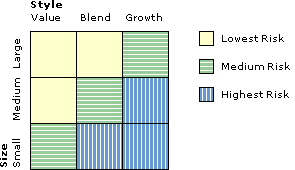| |
|
 |
| Style Boxes for Stock Funds |
| When you buy a stock fund, you want to know exactly what you're getting. That's why Morningstar
developed its style box. Think of our style box as a dresser with nine drawers. Each and every fund gets placed in one of these
drawers, depending on what kind of stocks it owns. |
 |
| Knowing which drawer your fund is in can help you out in three ways. First, you can compare your
fund's performance with other funds in the same part of the style box to see how it stacks up. Second, the style box can help
you when you go to pick new funds. If you already have a fund from one section of the style box, you probably won't want to
duplicate it by buying another. |
 |
| Finally, the style box tells you something about a fund's possible risks. As you can see,
funds from the bottom and right of the box are usually riskier than those from the top and left. |
| |
 |
| |
| To decide which section a fund goes in, we look
at two things: the size of the companies it owns and how cheap or pricey
those companies' stocks are. Size determines how far up in the style box
a fund lands, while stock value controls which column--left, right, or
middle--the fund sits in. |
| |
| To measure size, we use the total value a company's
stock, known as its market capitalization. Funds that invest in big companies
are in the top row, and those that buy small companies are at the bottom.
Funds that own medium-sized companies, or that buy both big- and small-company
stocks, wind up in the middle. |
| |
| Now for the other direction. Value funds, in the
left column, usually buy stocks that are relatively cheap (based on factors
such as a company's earnings) in the hope that their prices will recover.
Growth funds, on the right, typically buy fast-growing stocks that are
already expensive, hoping they'll keep shooting up. Blend funds buy either
both types or stocks that fall in the middle. |
|
|
| |